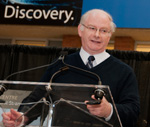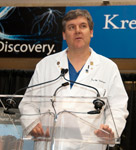
December 2010

 Cancer: Parallel Studies Change Current Understanding of Gene Function: Recent findings co-led by TWRI’s Dr. Rod Bremner revealed new information about E2fs—proteins believed to be essential for cell division. In studies focusing on the developing retina, the team showed that an unrelated protein family (Myc) could promote cell division in the absence of E2fs. Cancer cells often have high Myc levels, and if combined with low E2f levels, cells could be coaxed to divide and induce mutations to escape natural and pharmaceutical attack. [Abstract]
Cancer: Parallel Studies Change Current Understanding of Gene Function: Recent findings co-led by TWRI’s Dr. Rod Bremner revealed new information about E2fs—proteins believed to be essential for cell division. In studies focusing on the developing retina, the team showed that an unrelated protein family (Myc) could promote cell division in the absence of E2fs. Cancer cells often have high Myc levels, and if combined with low E2f levels, cells could be coaxed to divide and induce mutations to escape natural and pharmaceutical attack. [Abstract]
Leukemia: Discovering a New Population of Cells: The mechanisms involved in how a hematopoietic (blood) stem cell (HSC) undergoes self-renewal remain unclear. Dr. Norman Iscove (OCI) and his team have used a mouse model and a genetic approach to uncover a novel population of HSCs, referred to as ‘intermediate term’ cells, found as blood stem cells mature to become more specific types of blood cells. The ability to separate short-, intermediate- and long-term cells from one another is essential for studying the blood system and stem cell transplantation. [Abstract]
Heart Failure: Tracking Patients After Discharge: Heart failure (HF) is one of the leading reasons for hospitalization but for many patients with HF visiting the emergency department (ED) who are discharged home, little is known about their outcomes. By examining the acute care and early outcomes of patients with HF who visited an ED and were discharged without hospital admission, Dr. Douglas Lee (TGRI) and his colleagues discovered that recurrent ED visits or hospitalizations after initial discharge increased the risk of patient death 3.6  times. [Abstract]
times. [Abstract]
Regenerative Medicine: Repairing the Injured Spinal Cord: Findings from Dr. Michael Fehlings’ laboratory (TWRI) have revealed how to prepare sites of spinal cord damage for cell transplantation and the particular combination of specific growth proteins promoting function and repair of injured spinal cords. Findings here could bring scientists one step closer to the application of neuronal precursor cell or stem cell therapy for these patients. [Abstract]
Lupus: Understanding the Benefits of Antimalarial Treatment: Findings from a study led by TWRI’s Dr. Paul Fortin with Drs. Dafna Gladman and Murray Urowitz confirm that administration of the antimalarial drug hydroxychloroquine to patients who were diagnosed with systemic lupus erythematosus (SLE) between 1970 and 2004 reduced the risk of thrombovascular events by 68%. The data support the wide and prolonged use of hydroxychloroquine for the treatment of patients with SLE who do not have any contraindication to treatment with antimalarials. [Abstract]
Head and Neck Cancer: Global Screen Identifies Future Therapy Targets: OCI’s Dr. Fei-Fei Liu and her team examined the global expression of microRNAs—important molecules involved in the regulation of gene expression—in head and neck cancer (HNSCC) versus non-cancerous tissue and showed that 33% of the microRNAs were differentially expressed in the malignant tissues. These findings will fuel future studies that will look to further dissect the complex molecular activities that underlie HNSCC in an effort to develop a molecular disease signature and more effective treatment strategies. [Abstract]

Structural Biology: Understanding How Cells Anchor: Loss of cell adhesion—the ability of cells to anchor to one another—can lead to cells spreading from a primary cancer site to other locations (metastasis). Recent evidence from OCI’s Dr. Mitsuhiko Ikura and his team showed how the intimate structural interaction of two proteins, the cancer-promoting protein p120 and E-cadherin, is crucial for stabilizing cell adhesion—providing critical knowledge to our understanding of how cells lose the ability to anchor to each other, leading to metastasis. [Abstract]
 May
MayBreast Cancer: Evidence Points towards Hormone-Driven Cell Growth: OCI’s Dr. Rama Khokha and her team have discovered how hormones affect breast stem cells during the natural reproductive cycle. Using an animal model, they showed that the progesterone peak in the second half of the menstrual cycle affects breast stem cells and neighboring cells, causing normal breast stem cells to expand in number. This rapid cell expansion could trigger an environment where cancer could begin, a finding that provides important new knowledge about breast cancer initiation and prevention strategies. [Abstract]
Irritable Bowel Syndrome: Changes in Brain Landscape Linked to Disrupted Brain-Gut Communication: Patients with irritable bowel syndrome (IBS) suffer from abdominal pain, cramping, bloating and diarrhea—these symptoms are often associated with emotional distress. Previous studies from Drs. Karen Davis and Nicholas Diamant and their TWRI team revealed that IBS patients have an altered brain structure and, more recently, increased gray matter in the hypothalamus—which could be related to IBS and a brain-gut communication axis responsible for regulating food intake, digestion, gut sensations and control of bowel movements. [Abstract]
Immune System: Revising the ‘Road Map’ of Blood Development: With Dr. Pamela Ohashi (OCI) and colleagues, Dr. John Dick’s team (TGRI/OCI) isolated seven distinct bone marrow cell types that represent distinct nodes at which different blood cell fates are specified. During this process they uncovered the multilymphoid progenitor, which represents the earliest node from which white blood cells (including B and T cells) develop and that these cells can also develop into macrophages and dendritic cells—previously thought to arise from a different path. An accurate mapping of blood cell development is essential for the development of cell-based therapies. [Abstract]
 Cancer: Getting to the Root of Depression in Patients with Advanced Disease: OCI’s Dr. Gary Rodin and colleagues are providing strong evidence of the need for integrated approaches to address emotional and physical distress in patients with advanced metastatic gastrointestinal and lung cancer. In the first longitudinal predictive study of depression in 365 patients with metastatic cancer, they found that depressive symptoms in advanced cancer patients were three times more common in the final three months of life than in the year before and may occur as a final ‘common pathway of distress’ in response to the proximity to death, physical suffering and psychosocial vulnerabilities. [Abstract]
Cancer: Getting to the Root of Depression in Patients with Advanced Disease: OCI’s Dr. Gary Rodin and colleagues are providing strong evidence of the need for integrated approaches to address emotional and physical distress in patients with advanced metastatic gastrointestinal and lung cancer. In the first longitudinal predictive study of depression in 365 patients with metastatic cancer, they found that depressive symptoms in advanced cancer patients were three times more common in the final three months of life than in the year before and may occur as a final ‘common pathway of distress’ in response to the proximity to death, physical suffering and psychosocial vulnerabilities. [Abstract]
Influenza A: Identifying New Cell Population to Battle Infection: Recent findings from AARC and TGRI’s Dr. Eleanor Fish and her team uncover a new population of immune cells—late-activator antigen presenting cells (LAPC)—which may play a pivotal role in regulating resistance against pulmonary influenza A virus infections. Their studies show that they have distinct roles in the immune response to virus infections. For flu infection, they leave the lungs much later than other virus-fighting cells and trigger different responses. [Abstract]
Immunity and Disease: Applying Cell Therapy to Combat Infectious Disease: A team co-led by TGRI’s Dr. W. Conrad Liles and the University of Ottawa’s Dr. Duncan Stewart have found that administering mesenchymal stem (stromal) cells (MSCs)—stem cells from the bone marrow—to mice with sepsis (and receiving appropriate antimicrobial therapy) significantly reduced mortality in comparison to mice who did not receive MSC treatment. The study shows that by reducing inflammation and promoting the eradication of bacteria, MSC therapy may be an effective tool, in partnership with current therapies, to reduce sepsis-related morbidity and death. [Abstract]
Primary Biliary Cirrhosis: Confirming Gene Involvement: New findings from the laboratories of UHN’s Drs. Katherine Siminovitch, Jenny Heathcote and Gideon Hirschfield confirm that certain genes involved in primary biliary cirrhosis (PBC)—the most common autoimmune liver disease—have genetic overlap, or involvement, in other autoimmune diseases commonly found in patients with PBC and their families. Specifically, findings show that genetic risk loci for PBC are genes located in an area that is also involved in the development of systemic lupus erythematosus, systemic sclerosis and Sjögren's syndrome. Similarly, a second region of interest also shows increased risk and is associated with asthma, Crohn’s disease and type 1 diabetes. [Abstract]
 September
SeptemberLeukemia: Timing DNA Repair and Cell Death to Prevent Cancer: Hematopoietic stem cells (HSCs) are responsible for life-long blood production, and the strategies these cells use to protect against DNA damage are critical to understand in order to learn how the body prevents the development of leukemia. Findings from UHN’s Dr. John Dick have provided new insights into how human HSCs respond to DNA damage and are important for designing new approaches to harness HSC for stem cell transplantation to cure human diseases. [Abstract]
Alzheimer’s Disease: Investigating New Stimulating Treatment Techniques: TWRI’s Dr. Andres Lozano and colleagues have completed the first multi-patient phase I trial investigating the effects of using deep brain stimulation (DBS) for patients with mild Alzheimer’s disease (AD). They determined that DBS drove neural activity in the memory circuit and reversed impaired glucose metabolism in areas that were dysfunctional and accumulate plaques—one of the defining characteristics of damage in AD—early on, effects that were maintained up to a year after the study. These findings suggest that DBS may improve and/or slow the rate of cognitive decline in patients with AD. [Abstract]
 Neuroscience: The Cellular Basis of Neural Impulse Transmission: Communication between neurons occurs through a process called synaptic transmission, during which calcium ions enter the cell, triggering the release of neurotransmitters—the molecules responsible for transmitting the signal to the next cell. Thanks to TWRI's Dr. Elise Stanley, it is now established that during synaptic transmission the fusion of a secretory vesicle can be triggered by the plume of calcium entering through a very closely situated single calcium channel. Since transmitter release is involved in virtually every aspect of nervous system function, these results have a very broad impact for the understanding of normal brain processing. [Abstract]
Neuroscience: The Cellular Basis of Neural Impulse Transmission: Communication between neurons occurs through a process called synaptic transmission, during which calcium ions enter the cell, triggering the release of neurotransmitters—the molecules responsible for transmitting the signal to the next cell. Thanks to TWRI's Dr. Elise Stanley, it is now established that during synaptic transmission the fusion of a secretory vesicle can be triggered by the plume of calcium entering through a very closely situated single calcium channel. Since transmitter release is involved in virtually every aspect of nervous system function, these results have a very broad impact for the understanding of normal brain processing. [Abstract]
Diabetes: Detecting Sugar Sensing Pathways in the Brain: TGRI’s Dr. Tony Lam and colleagues have uncovered the brain's circuitry involving the forebrain and hindbrain that is necessary for the processing and ‘sensing’ of sugar in the blood. By blocking activity of the N-methyl-D-aspartate receptor in the dorsal vagal complex of the hindbrain, they showed that this receptor is necessary for the hypothalamus to detect blood sugar to lower the production of glucose. The findings lend important new knowledge to our understanding of how the brain processes signals from the blood to account for, and deal with, the proper processing of sugar. [Abstract]
Cardiology: The Immune Switch of Stem Cells: Cell therapy, or treatment using stem cells, is a promising method for repairing damage to heart tissue following a myocardial infarction. TGRI researchers Drs. Ren-Ke Li, Richard Weisel and Li Zhang evaluated the effects of stem cells originating from young healthy donors on repairing damaged cardiac tissue and found that they provide short-term benefit when the cells are undifferentiated, or non-specific. However, after the cells differentiate into specific tissues, they undergo an immune “switch”, which results in activation of the immune system and rejection of these cells. These results have important implications for the use of cell therapy to treat heart disease. [Abstract]
Epilepsy: Linking Impaired Blood Flow with Seizures: Epileptic seizures are common in patients that have been diagnosed with masses of abnormal blood vessels that grow in their brains (brain arteriovenous malformations). A recent magnetic resonance imaging study from TWRI’s Dr. David Mikulis investigated this phenomenon and revealed that the capacity of the brain vessels around the brain arteriovenous malformations to control blood flow in these seizure-prone patients was impaired, suggesting an associative link between impaired blood flow and seizure presentation.

TWRI Breaks Ground on Krembil: Thursday, March 4, 2010 marked the beginning of a new era in research and innovation at TWRI with the official groundbreaking ceremony of the highly anticipated Krembil Discovery Centre (KDC). Watch this historic event unfold as told through the photos below:








UHN and Merck Join Efforts for Cancer Research: On April 15, 2010, UHN joined Merck’s global oncology research network—a group of leading international cancer research institutes working together to accelerate the development of cancer drugs for patients—as a centre of excellence for clinical trials of new anti-cancer drugs.
Over the next five years, UHN will receive $17.5M—of which $2.6M are being invested by the Ontario government through its Biopharmaceutical Investment Program. PMH/OCI will aim to develop a new generation of cancer treatments based on genomics, stem cell research and personalized medicine. OCI Director Dr. Benjamin Neel and PMH’s Dr. Malcolm Moore will be leading the partnership.
UHN Captures $40M in New Ministry Funding: The Ontario Ministry of Research and Innovation has announced $40M in new funding to seven UHN-led programs in areas of research spanning cancer, cardiology, vision, lung transplant and computational biology.
UHN awardees in the Ontario Research Fund-Research Excellence Round 4 include:
- “Ontario Consortium for Adaptive Interventions in Radiation Oncology”, led by Dr. David Jaffray, $7M
- “Retinal Oxygen Saturation, Blood Flow, Vascular Function and High Resolution Morphometric Imaging in the Living Human Eye”, led by Dr. Christopher Hudson, $2.4M
UHN awardees in the Ontario Research Fund-Global Leadership Round in Genomics & Life Sciences (GL2) include:
- “Functional Genomics of Solid Tumours for Discovery and Development of New Biologics and Biomarkers”, led by Drs. Benjamin Neel and Bradly Wouters, $10.1M
- “Cancer Gene Encyclopedia (CGEP): Computationally Optimized Characterization of Cancer Genes, Proteins, Their Structure, Function and Interactions”, led by Drs. Igor Jurisica and Gary Bader
- “Cardiovascular Biomarker Discovery in Disease and Development through Predictive Precision Proteomics (CBD3P3)”, led by Drs. Gordon Keller and Peter Liu, $6.6M
- “Functional Oncogenomics for the Discovery of Cancer Drivers and Unique Subclasses (FOCUS)”, led by Dr. Rama Khokha, $2.1M
- “Molecular and Genomic Diagnostics to Improve Outcomes in Lung Transplantation”, led by Drs. Shaf Keshavjee and Mingyao Liu, $1.75M
 ELLICSR Opens Its Doors: The Electronic Living Laboratory for Interdisciplinary Cancer Survivorship Research (ELLICSR) celebrated the official opening of its 12,000 square foot research centre at Toronto General Hospital on June 4, 2010. Led by Dr. Pamela Catton, Medical Director of the Cancer Survivorship Program, this unique facility was made possible by grant contributions from the Canada Foundation for Innovation ($1.2M) and the Ministry of Research and Innovation ($1.2M). ELLICSR’s mission is to improve the cancer experience by exploring new ways to learn from survivors, to develop new survivorship communities and to study how cancer survivors can be engaged, empowered and active in adopting healthier behaviours that minimize the negative impact of cancer and its treatment.
ELLICSR Opens Its Doors: The Electronic Living Laboratory for Interdisciplinary Cancer Survivorship Research (ELLICSR) celebrated the official opening of its 12,000 square foot research centre at Toronto General Hospital on June 4, 2010. Led by Dr. Pamela Catton, Medical Director of the Cancer Survivorship Program, this unique facility was made possible by grant contributions from the Canada Foundation for Innovation ($1.2M) and the Ministry of Research and Innovation ($1.2M). ELLICSR’s mission is to improve the cancer experience by exploring new ways to learn from survivors, to develop new survivorship communities and to study how cancer survivors can be engaged, empowered and active in adopting healthier behaviours that minimize the negative impact of cancer and its treatment.

![]()
 Congratulations to OCI Senior Scientist Dr. Mitsuhiko Ikura who has been recognized by the Canadian Cancer Society with the 2010 Robert L. Noble Prize, given for outstanding achievements in cancer research.
Congratulations to OCI Senior Scientist Dr. Mitsuhiko Ikura who has been recognized by the Canadian Cancer Society with the 2010 Robert L. Noble Prize, given for outstanding achievements in cancer research.A Tier I Canada Research Chair in Cancer Structural Biology, Dr. Ikura is being recognized for his groundbreaking findings in the field of cancer signaling protein structural biology. Over the course of his career, Dr. Ikura’s research has significantly expanded our understanding of signaling proteins and processes involved in human diseases such as cancer, neurological disorders and heart disorders.
 Dr. Camilla Zimmermann, OCI Scientist and Medical Director of the Harold and Shirley Lederman Palliative Care Centre at PMH, is being recognized by the Canadian Cancer Society’s 2010 William E. Rawls Prize as a young investigator whose work has led to important advances in cancer control within the past decade.
Dr. Camilla Zimmermann, OCI Scientist and Medical Director of the Harold and Shirley Lederman Palliative Care Centre at PMH, is being recognized by the Canadian Cancer Society’s 2010 William E. Rawls Prize as a young investigator whose work has led to important advances in cancer control within the past decade. Dr. Zimmermann’s research focuses on improving our understanding of the effectiveness of palliative care service delivery, including symptom control and psychosocial support, and of when along the trajectory of illness such services are indicated.
 UHN congratulates Dr. Richard Weisel for being awarded the American Association for Thoracic Surgery (AATS) Scientific Achievement Award as an individual who has made extraordinary scientific contributions in the field of thoracic surgery. It is the highest Award the AATS can bestow on a member.
UHN congratulates Dr. Richard Weisel for being awarded the American Association for Thoracic Surgery (AATS) Scientific Achievement Award as an individual who has made extraordinary scientific contributions in the field of thoracic surgery. It is the highest Award the AATS can bestow on a member.
Dr. Weisel's research interests have been in the fields of myocardial protection and stem cell therapy. He is being recognized by the AATS for his combination of basic experimental and clinical investigations in the intensive care unit, which has resulted in a new measure of heart function, as well as for having elucidating the molecular events of myocardial ischemia-reperfusion injury.
Drs. Islam and Sharpe have added 16 inventions to their portfolio since 2004, half of which are from last year alone. Their web-based treatment plan approval software has been licensed to Philips and is in use in twenty hospitals worldwide, while a patient immobilization device and an image-guided radiation therapy phantom has been licensed to Bionix and Modus Medical Devices, respectively.
In addition, UHN commends Drs. John Dick (Tier I Canada Research Chair in Stem Cell Biology), Mitsuhiko Ikura (Tier I Canada Research Chair in Cancer Structural Biology) and Brian Raught (Tier II Canada Research Chair in Proteomics and Molecular Medicine) on the renewal of their Canada Research Chairs.
 UHN welcomed Dr. Jason Fish as a new Scientist to the Toronto General Research Institute, Division of Cellular & Molecular Biology. Dr. Fish joined UHN from the Gladstone Institute of Cardiovascular Disease at the University of California, San Francisco where he spent a number of years developing embryonic stem cell and zebrafish model systems to study microRNA biology and vascular development under the supervision of Dr. Deepak Srivastava.
UHN welcomed Dr. Jason Fish as a new Scientist to the Toronto General Research Institute, Division of Cellular & Molecular Biology. Dr. Fish joined UHN from the Gladstone Institute of Cardiovascular Disease at the University of California, San Francisco where he spent a number of years developing embryonic stem cell and zebrafish model systems to study microRNA biology and vascular development under the supervision of Dr. Deepak Srivastava. His research at TGRI will focus on determining the molecular mechanisms that direct the specification of endothelial cells that line blood vessels (vasculogenesis), and that control the formation and growth of new blood vessels (angiogenesis).
 Dr. Catherine O’Brien joined the Ontario Cancer Institute as a Scientist and PMH Cancer Program Member. Catherine came to UHN following a surgical oncology fellowship at the University of Toronto and doctoral studies on cancer stem cells in colon cancer under the supervision of Drs. John Dick and Steven Gallinger. Her research is focused on the biology and pathways that regulate colon cancer stem cells in translational medicine.
Dr. Catherine O’Brien joined the Ontario Cancer Institute as a Scientist and PMH Cancer Program Member. Catherine came to UHN following a surgical oncology fellowship at the University of Toronto and doctoral studies on cancer stem cells in colon cancer under the supervision of Drs. John Dick and Steven Gallinger. Her research is focused on the biology and pathways that regulate colon cancer stem cells in translational medicine.
 Dr. Jeremy Sivak, Scientist and UHN Glaucoma Research Chair, officially joined the Toronto Western Research Institute. Dr. Sivak's laboratory investigates the molecular pathways underpinning damage and repair responses in the eye. His research employs models of retinal damage coupled with gain- and loss-of-function approaches to study these pathways in the context of glaucomatous optic neuropathy and ganglion cell death.
Dr. Jeremy Sivak, Scientist and UHN Glaucoma Research Chair, officially joined the Toronto Western Research Institute. Dr. Sivak's laboratory investigates the molecular pathways underpinning damage and repair responses in the eye. His research employs models of retinal damage coupled with gain- and loss-of-function approaches to study these pathways in the context of glaucomatous optic neuropathy and ganglion cell death. Dr. Rodger Tiedemann Joins OCI
UHN welcomed Dr. Rodger Tiedemann, a New Zealand-trained hematologist/ oncologist and expert in multiple myeloma, as a Scientist at the Ontario Cancer Institute. Rodger comes to UHN via Scottsdale, Arizona’s Mayo Clinic where he held an Assistant Professorship of Medicine. His laboratory is engaged in high-throughput genome-scale RNA interference screens in multiple myeloma to identify vulnerable novel therapeutic targets.




Feedback/To Unsubscribe
Happy Holidays! Net Results EXPRESS is brought to you by UHN Research Communications. We hope you have enjoyed receiving this message. If you have any feedback, or if you wish to unsubscribe, please email www@uhnresearch.ca.